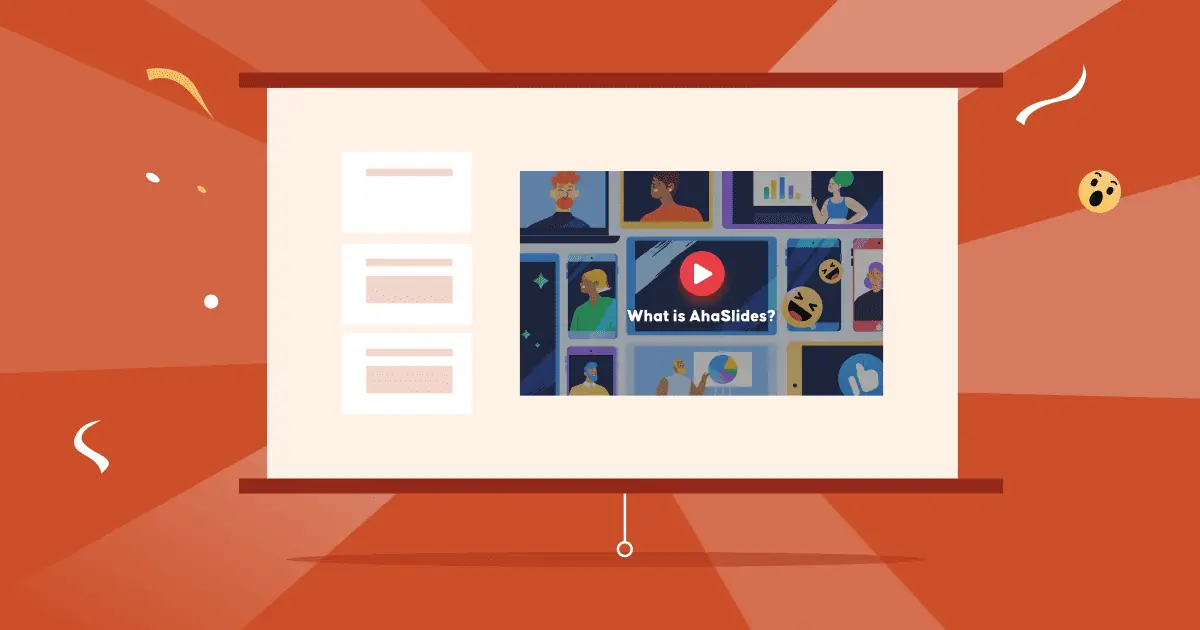Jak debatować dla początkujących? Kłócenie się to bardzo, bardzo ważny temat. Jeśli nigdy wcześniej tego nie robiłeś, może być przytłaczające myślenie o tym, co się stanie i jak możesz uniknąć wyglądania na całkowicie bezradnego przed wszystkimi.
Jest wiele do nauczenia się, zanim będziesz mógł zebrać odwagę, by stanąć na podium. Ale nie martw się; ten przewodnik po debatach dla początkujących da ci kroki, wskazówki i przykłady, których potrzebujesz, aby zachwycić swoją następną debatę. Sprawdźmy więc te wspaniałe wskazówki dotyczące debat!
Spis treści
- 7 kroków do rozpoczęcia debaty dla początkujących
- 10 wskazówek dla nowych debatujących
- 6 stylów debat
- 2 przykłady debat
- Więcej wskazówek dotyczących AhaSlides
Więcej wskazówek dotyczących AhaSlides

Zacznij w kilka sekund.
Pobierz bezpłatne szablony debat studenckich. Zarejestruj się za darmo i weź to, co chcesz z biblioteki szablonów!
🚀 Uzyskaj bezpłatne szablony ☁️
Jak działa debata dla początkujących (w 7 krokach)
Zanim zaczniesz formułować swoje argumenty jak profesjonalista, musisz wiedzieć, jak działa debata dla początkujących. Zapoznaj się z tymi 7 krokami do debaty dla nowicjuszy i dowiedz się, co musisz zrobić po drodze, a wtedy całkowicie zrozumiesz, jak zostać lepszym debatantem!
1. Cel jest zdecydowany

Ponieważ możemy wykorzystywać debaty w wielu miejscach i sytuacjach, takich jak szkoły, spotkania firmowe, dyskusje panelowe lub ciała polityczne, kluczowe jest, aby najpierw wybrać główne cele debaty. Może to dać jasny obraz planu i organizacji debat, ponieważ później jest wiele szczegółów do opracowania, z których wszystkie muszą być spójne.
Tak więc, przede wszystkim, moderator odpowie na to pytanie – jakie są cele tej debaty??
Na przykład, jeśli jesteś w debata studencka, cele powinny być takie same jak w Twojej lekcji, czyli zachęcać uczniów do krytycznego myślenia i umiejętności publicznego przemawiania. Jeśli to działa, może to być decyzja, który z dwóch pomysłów wybrać.
2. Struktura jest wybrana
Pytając, jak dobrze debatować, musisz mieć strukturę. Istnieje wiele odmian struktury debaty i wiele formatów w ich obrębie. Ważne jest, aby najpierw poznać podstawowe terminy używane w wielu typowych typach debat, zanim zaczniesz przygotowywać się do debaty…
- Temat – Każda debata ma temat, który formalnie nazywa się ruch or rozkładTematem może być stwierdzenie, polityka lub pomysł, zależy to od otoczenia i celu debaty.
- dwa Zespoły - Twierdzący (wspierający wniosek) i Negatywne (sprzeciw wobec wniosku). W wielu przypadkach każdy zespół składa się z trzech członków.
- Sędziowie or Sędziowie: Ludzie, którzy oceniają jakość argumentów w dowodach i występach dyskutantów.
- Chronometrażysta – Osoba, która śledzi czas i zatrzymuje zespoły, gdy czas się skończy.
- Obserwatorzy – W debacie mogą uczestniczyć obserwatorzy (publiczność), ale nie mają oni prawa zabierać głosu.
Do debaty dla początkujących, po otrzymaniu wniosku, zespoły będą miały czas na przygotowania. ten Twierdzący zespół rozpoczyna debatę z pierwszym mówcą, a następnie z pierwszym mówcą z Negatywne zespół. Następnie trafia do drugiego głośnika w Twierdzący zespół, wróćmy do drugiego mówcy w Negatywne zespół i tak dalej.
Każdy mówca wygłosi dyskusję i przedstawi swoje punkty w wyznaczonym w regulaminie czasie terminie. Pamiętaj, że nie cała kolekcja debaty kończą się zespołem Negatywne; czasami zespół Twierdzący zostanie poproszony o zakończenie.
Ponieważ prawdopodobnie jesteś w tym temacie nowy, możesz znaleźć proces debaty dla początkujących poniżej. Jest łatwy do naśladowania i można go używać w wielu różnych typach debat.
3. Plan debaty jest gotowy
Aby debata przebiegała sprawnie, osoba ją prowadząca musi mieć plan, który: tak szczegółowe, jak to możliwe. Powinni dać ci znać o tym planie, ponieważ pomoże ci to zwizualizować wszystko i uchroni cię przed zboczeniem z trasy, co jest bardzo łatwe, gdy bierzesz udział w debacie dla początkujących.
Oto prosta lista kontrolna tego, co powinien zawierać plan:
- Cel debaty
- Struktura
- Jak zostanie urządzony pokój
- Oś czasu i czas dla każdego okresu
- Formalne zasady debaty oraz instrukcje dla prelegentów i sędziów
- Szablony do robienia notatek dla ról
- Podsumowanie zamknięcia debaty po jej zakończeniu
4. Pokój jest zaaranżowany
W trakcie debaty otoczenie odgrywa istotną rolę, gdyż w pewnym stopniu może wpływać na występy mówców.
Twoja debata powinna mieć jak najbardziej profesjonalną atmosferę. Istnieje wiele sposobów na ustawienie sali debat, ale niezależnie od tego, którą konfigurację wybierzesz, wszystko będzie się koncentrować wokół „strefy mówcy” na środku. To właśnie tam będzie się dziać cała magia debaty.
Każdy mówca reprezentujący obie drużyny będzie stał w strefie mówcy podczas swojej tury, a po zakończeniu wróci na swoje miejsce.
Poniżej znajduje popularny przykład układu na debatę dla początkujących:
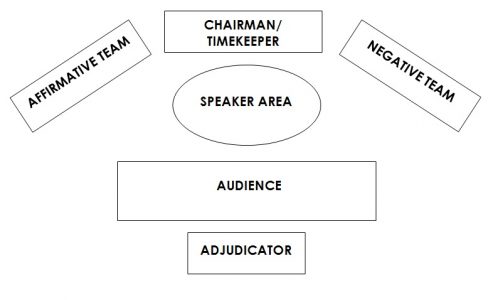
Oczywiście, zawsze istnieje możliwość przeprowadzenia debaty online. Możesz mieć trudności z odczuciem tej samej atmosfery w debacie online dla początkujących, ale jest kilka sposobów, aby ją urozmaicić:
- Personalizacja tła: Każda rola może mieć inne tło Zoom: gospodarz, chronometrażysta, sędziowie i każdy zespół. Może to pomóc w rozróżnieniu ról każdego uczestnika i wzbudzić dumę z nadanej roli.
- Urządzenia wspierające:
- Regulator czasowy: Czas jest ważny w debacie, zwłaszcza dla początkujących, którzy po raz pierwszy wychodzą. Twój facylitator może zdecydować o śledzeniu twojego tempa za pomocą timera na ekranie (chociaż w większości debat sędzia mierzący czas po prostu sygnalizuje, kiedy pozostała 1 minuta lub 30 sekund).
- Efekty dźwiękowe: Pamiętaj, że to debata tylko dla początkujących. Możesz oczekiwać, że Twój facylitator rozjaśni atmosferę zachęcając klaskanie efekty dźwiękowe kiedy mówca kończy swoją przemowę.
5. Drużyny są wybierane
Drużyny zostaną podzielone na Twierdzący oraz Negatywne. Zazwyczaj zespoły i pozycje mówców w tych zespołach są losowe, więc moderator może użyć koło zamachowe aby proces był bardziej ekscytujący i wciągający.
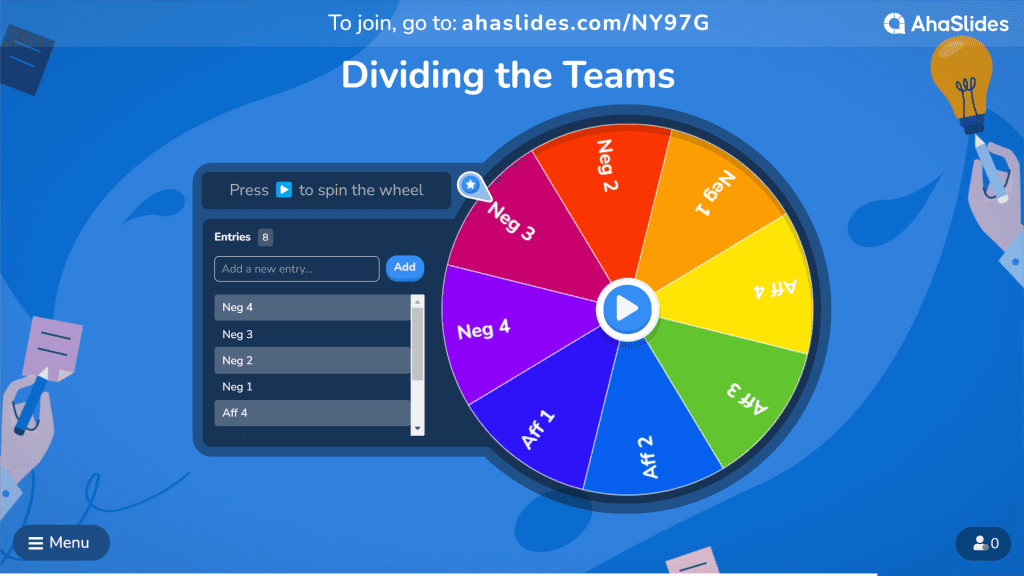
Po wybraniu dwóch zespołów wniosek zostanie ogłoszony, a Ty będziesz mieć trochę czasu na przygotowanie się, najlepiej godzinę.
W tym czasie moderator wskaże wiele różnych zasobów, aby zespoły mogły zrozumieć kontekst i problemy, aby uzyskać mocniejsze punkty. Im więcej wiesz, tym bardziej ożywiona jest debata.
6. Rozpoczyna się debata
Każdy inny rodzaj debaty wymaga innego formatu i może istnieć wiele odmian. Poniżej znajduje się bardzo popularna wersja, którą można wykorzystać w każdej debacie dla początkujących.
Każda drużyna ma cztery tury na zabranie głosu w tej debacie, więc najlepiej, aby było 6 lub 8 mówców. W przypadku 6, dwóch debatantów będzie mówić dwa razy.
| Przemówienie | Czas | Obowiązki dyskusyjnych |
| 1. twierdząca konstruktywna | 8 min | Przedstaw ruch i ich punkt widzenia Podaj ich definicje kluczowych terminów Przedstaw swoje argumenty na poparcie wniosku |
| 1. Negatywna konstruktywna | 8 min | Podaj swoje argumenty, aby sprzeciwić się wnioskowi |
| 2. twierdząca konstruktywna | 8 min | Przedstaw dalsze argumenty na poparcie wniosku i opinie zespołu Zidentyfikuj obszary konfliktu Odpowiedz na pytania negatywnego mówcy (jeśli istnieje) |
| 2. Negatywna konstruktywna | 8 min | Przedstaw dalsze argumenty przeciwko wnioskowi i wzmocnij opinie zespołu Zidentyfikuj obszary konfliktu Odpowiedz na pytania mówcy twierdzącego (jeśli istnieje) |
| 1. Negatywna obalenie | 4 min | Broń Negatywne argumenty zespołu i obalenie argumentów wspierających bez dodawania nowych argumentów lub informacji |
| 1. twierdząca obalenie | 4 min | Broń Twierdzący argumenty zespołu i obalenie przeciwnych argumentów bez dodawania nowych argumentów lub informacji |
| Drugie negatywne odparcie (Oświadczenie końcowe) | 4 min | Miej drugie obalenie i oświadczenia końcowe |
| 2. twierdząca obalenie (Oświadczenie końcowe) | 4 min | Miej drugie obalenie i oświadczenia końcowe |
💡 W zależności od zasad może minąć trochę czasu na przygotowanie się do obaleń.
Możesz zobaczyć przykład wideo tego formatu Tu na dole.
7. Osądź debatę
Czas na pracę sędziów. Muszą oni obserwować debaty i występy każdego uczestnika debaty, a następnie je oceniać. Oto niektóre z rzeczy, na które będą zwracać uwagę w Twoim występie…
- Organizacja i przejrzystość – Struktura Twojej przemowy – czy ma sens przedstawić ją w taki sposób, w jaki to zrobiłeś?
- Treść – Przedstawiasz te argumenty, dowody, przesłuchania krzyżowe i repliki.
- Sposób dostawy i prezentacji – Sposób przekazywania swoich racji, w tym mowa ciała i mowa ciała, wyraz oczu oraz używany ton głosu.
10 wskazówek dla nowych debatujących
Nikt nie jest w stanie opanować wszystkiego od początku, a jeśli nigdy w życiu nie debatowałeś, niełatwo jest zacząć. Poniżej znajdują się 10 szybkich wskazówek odkryć, jak skutecznie debatować i dotrzymać kroku nowicjuszom w każdej debacie.
#1 - Przygotowanie to podstawa – Zbadaj temat dużo wcześniej, aby uzyskać nie tylko podstawowe informacje, ale także pewność siebie. Może to pomóc początkującym dyskutantom w lepszym zrozumieniu zagadnień i dobrym rozpoczęciu obalenia argumentów, a następnie przygotowaniu argumentów, znalezieniu dowodów i uniknięciu wchodzenia do króliczych norek. Każdy dyskutant powinien opisać wszystko w punktach (najlepiej 3 punkty za 3 argumenty), aby lepiej uporządkować pomysły i zobaczyć „szerszy obraz” swojego wystąpienia.
#2 - Trzymaj wszystko w temacie – Jednym z grzechów debatowania jest zbaczanie z tematu, ponieważ marnuje to cenny czas wypowiedzi i osłabia argumentację. Zwróć uwagę na zarysy i główne punkty, aby upewnić się, że podążają za tematem i poruszają właściwe problemy.
#3 - Wyrażaj swoje punkty na przykładach – Podawanie przykładów sprawia, że zdania w debacie są bardziej przekonujące, a ludzie widzą rzeczy wyraźniej, np. to przykład poniżej…
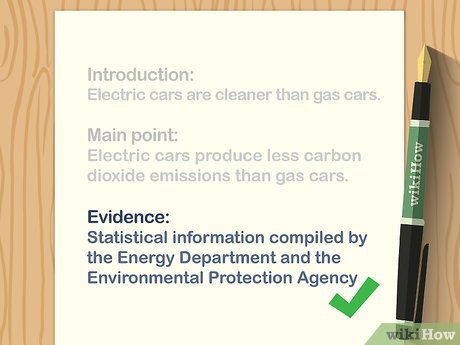
#4 - Staraj się myśleć jak przeciwnicy – Podczas przeglądania pomysłów pomyśl o punktach, które może przedstawić opozycja. Zidentyfikuj kilka i zapisz mapę myśli z odpowiedziami, które mógłbyś przedstawić, gdyby do w końcu robiąc te punkty.
#5 - Miej mocny wniosek – Zakończ debatę kilkoma dobrymi zdaniami, które przynajmniej podsumowują główne punkty. W wielu przypadkach debatanci lubią kończyć z mocą, jednym poetycko skonstruowanym zdaniem, aby to spowodować upuszczenie mikrofonu za chwilę (sprawdź przykład tego poniżej).
#6 - Bądź pewny siebie (lub udawaj, aż ci się uda!) – Jedną z najważniejszych rzeczy, jeśli chodzi o to, jak być lepszym w debatowaniu, jest atmosfera. Debatanci muszą być pewni tego, co mówią, ponieważ pewność siebie ma ogromny wpływ na sędziów i obserwatorów. Oczywiście, im bardziej się przygotujesz, tym będziesz bardziej pewny siebie.
#7 - Mów powoli – Bardzo częstym problemem początkujących debatantów jest tempo mówienia. Często za pierwszym razem jest ono zbyt szybkie, co powoduje niepokój zarówno u słuchaczy, jak i u mówcy. Weź głęboki oddech i mów powoli. Możesz powiedzieć mniej, ale to, co wyprodukujesz, będzie miało powagę.
#8 - Użyj swojego ciała i twarzy – Mowa ciała może wspierać twoje argumenty i pokazywać pewność siebie. Patrz przeciwnikom w oczy, przyjmij ładną postawę stojącą i kontroluj mimikę twarzy (nie bądź zbyt agresywny), aby przyciągnąć uwagę.
#9 - Słuchaj uważnie i rób notatki – Debatanci muszą zwracać uwagę na każdą przemowę i pomysł, aby nadążać za tempem, wspierać swoich kolegów z drużyny i lepiej obalać argumenty przeciwników. Posiadanie notatek może bardzo pomóc, ponieważ nikt nie jest w stanie zapamiętać każdego punktu, aby obalić lub rozwinąć go dalej. Pamiętaj, aby zapisywać tylko kluczowe punkty.
#10 - Unikaj tanich strzałów – Skup się i odrzuć argumenty przeciwników, a nie samych przeciwników. Żaden z dyskutantów nie powinien obrażać innych; to pokazuje brak profesjonalizmu i na pewno zostaniesz za to ukarany.
6 stylów debat dla początkujących
Istnieje wiele stylów debat o różnych formatach i zasadach. Dokładna znajomość niektórych z nich może pomóc początkującym dyskutantom zrozumieć proces i to, co muszą zrobić. Oto kilka typowych stylów debaty, które możesz zobaczyć podczas swojej pierwszej debaty!
1. Debata polityczna – To powszechny typ, który wymaga wielu badań. Debata dotyczy tego, czy wprowadzić konkretną politykę, czy nie, i zwykle w formie dwóch osób więcej w zespole. Debata polityczna jest stosowany w wielu szkołach, ponieważ jest praktyczny, a zasady są łatwiejsze do przestrzegania niż w przypadku innych typów.
2. Debata parlamentarna – Ten styl debaty opiera się na brytyjskim modelu rządowym i debatach w brytyjskim parlamencie. Najpierw przyjęty przez brytyjskie uniwersytety, obecnie jest to oficjalny styl debaty wielu dużych konkursów debat, takich jak The World University Debating Championship i European Universities Debating Championship. Taka debata jest dowcipna i krótsza niż tradycyjna polityka debatę, dzięki czemu nadaje się do wielu przypadków, od gimnazjów po uniwersytety.
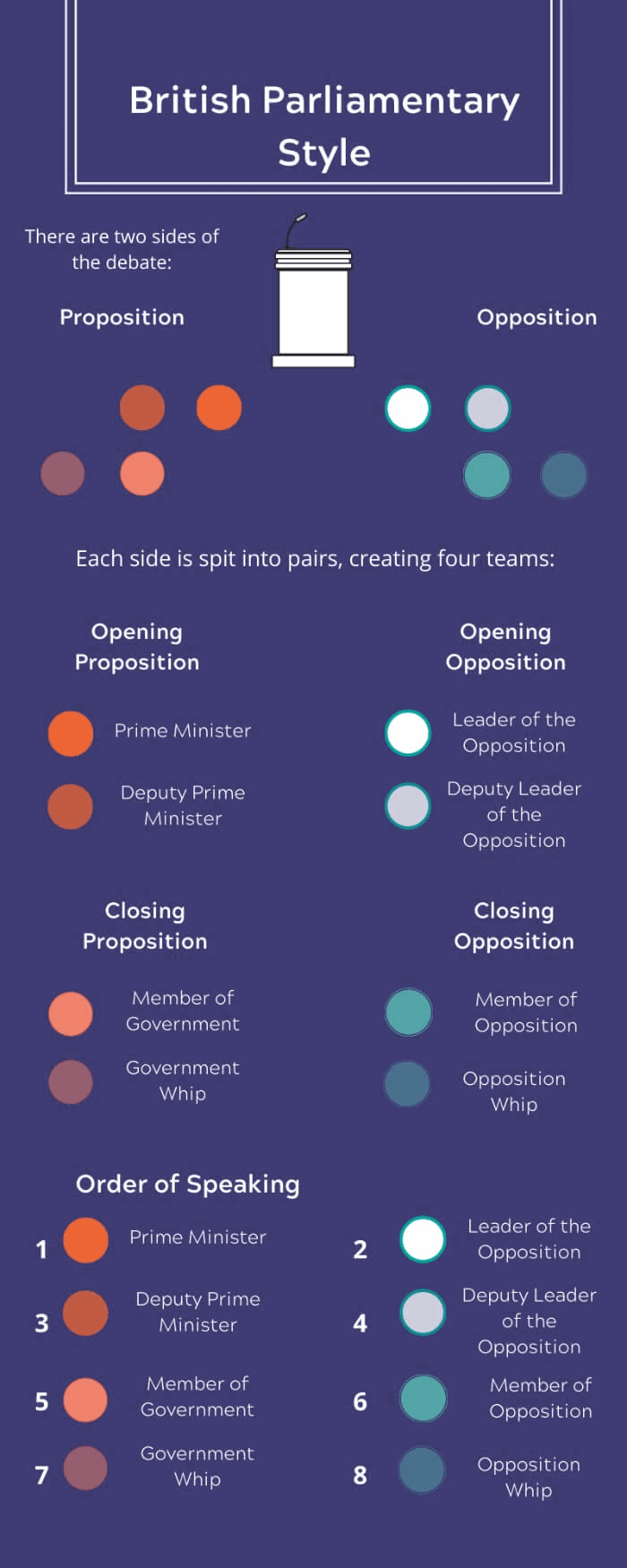
3. Debata na forum publicznym – W tym stylu dwa zespoły debatują nad „gorącymi” i kontrowersyjnymi tematami lub bieżącymi wydarzeniami. To tematy, na temat których prawdopodobnie masz już opinię, więc ten typ debaty jest bardziej dostępny niż polityka debata.
4. Lincolna Douglasa debata– To otwarty styl debaty jeden na jeden, nazwany na cześć słynnej serii debat z 1858 r. między kandydatami do Senatu USA Abrahamem Lincolnem i Stephenem Douglasem. W tym stylu debatanci skupiają się na głębszych lub bardziej filozoficznych pytaniach, głównie dotyczących istotnych kwestii.
5. Spontaniczny argumentacja – Dwóch debatantów spiera się o jeden konkretny temat; muszą oni sformułować swoje argumenty w bardzo krótkim czasie i szybko odpowiedzieć na pomysły swoich przeciwników bez większego przygotowania. Wymaga to silnych umiejętności argumentacyjnych i może pomóc zwiększyć pewność siebie i pokonać tremę.
6. Kongresowy debata – Ten styl jest symulacją ustawodawstwa USA, w którym debatanci naśladują członków Kongresu. Debatują nad aktami prawnymi, w tym projektami ustaw (projektami ustaw), rezolucjami (oświadczeniami stanowisk). Następnie pozorowany Kongres głosuje nad uchwaleniem prawa i nadal głosuje za lub przeciw ustawodawstwu.
2 przykłady debat
Oto dwa przykłady debat, które pozwolą Ci lepiej zrozumieć, jak do nich dochodzi…
1. Debata parlamentu brytyjskiego
To krótki klip z debaty między byłą brytyjską premier Theresą May i byłym liderem Partii Pracy, Jeremym Corbynem. Dynamiczna atmosfera debaty i gorące argumenty są typowe dla tego rodzaju hałaśliwych debat. Ponadto May zakończyła swoje przemówienie tak mocnym stwierdzeniem, że stało się nawet viralem!
2. Dyskutanci
Debaty studenckie stają się coraz bardziej popularnym zjawiskiem w szkole; niektóre dobrze przeprowadzone debaty mogą być nawet tak angażujące jak debaty dorosłych. Ten film to jeden odcinek z anglojęzycznego wietnamskiego programu debaterskiego – The Debaters. Ci uczniowie szkół średnich debatowali nad wnioskiem „Oklaskujemy Gretę Thunberg” w dość powszechnym formacie 3 na 3.





